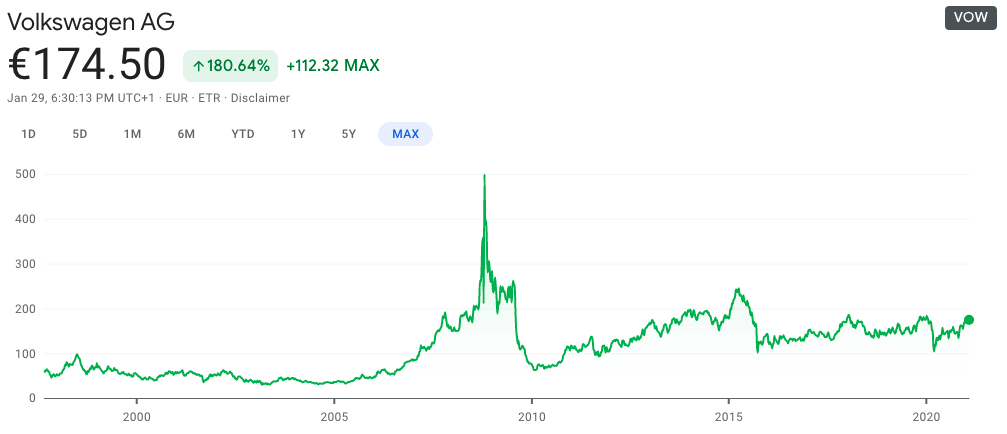The Volkswagen Infinity Squeeze that Squoze
 Volkswagen AG stock price surges from €30 to a peak close of €499.50 during a short squeeze in 2008
Volkswagen AG stock price surges from €30 to a peak close of €499.50 during a short squeeze in 2008
The situation with GameStop (NYSE: GME) stock was not unprecedented. In the early innings of the Great Financial Crisis, the stock of Volkswagen AG (ETR: VOW) went vertical. Over the course of two years, Volkswagen AG stock went from a €50 to a peak over €1000 one day in intra-day trading. The circumstances of Volkswagen were similar to GameStop in that both business were struggling and had high short interest in their stock. The resemblances stop there. The Volkswagen story happened mostly due to a large private investor, Porsche, trying to accumulate voting rights and selectively disclosing their holdings. On the other hand, the GameStop saga started by getting the attention of deep value investors and a large horde of momentum traders by tapping powerful network effects of a popular Internet forum, Reddit’s r/wallstreetbets.
There is plenty more to both stories at other publications listed below. Next week, we will be back to discussing industrial technology.
- The day Volkswagen briefly conquered the world by the Financial Times (paid)
- Here’s How the GameStop Short Squeeze Is like the VW Squeeze of 2008 by Autoweek (free)
- The ‘Roaring Kitty’ Rally: How a Reddit User and His Friends Roiled the Markets by The New York Times (limited free)
Visual Inspection
AWS Predictive Quality Industrial Demo
Assembly Line
Sensor Fusion: The Swiss Army Knife of Digitalization
With the proper communication protocols and network architecture in place, smart sensor technology and the data it provides can be the bulwark on which digital transformation is built.
If industrial control systems are the brains of a plant, then sensors are its eyes and ears. Simply put, without sensors there would be nothing for SCADA, DCS, or PLCs to respond to. That’s why increasingly intelligent or ‘smart’ sensors packing more onboard processing power, the ability to monitor new variables, and digital communication capabilities are playing such an important role in helping plant operators and enterprise level planners alike to see better and respond to problems with more finesse.
Report: Innovative New Machinery at PACK EXPO Connects
As flexible packaging continues to grow in popularity partly due to its sustainability bona fides, it comes as no surprise that innovations in both vertical and horizontal form/fill/seal systems were on full display at PACK EXPO Connects. Here we take a brief look at seven notable developments.
Building effective IoT applications with tinyML and automated machine learning
The convergence of IoT devices and ML algorithms enables a wide range of smart applications and enhanced user experiences, which are made possible by low-power, low-latency, and lightweight machine learning inference, i.e., tinyML.
Pushing The Frontiers Of Manufacturing AI At Seagate
Big data, analytics and AI are widely used in industries like financial services and e-commerce, but are less likely to be found in manufacturing companies. With some exceptions like predictive maintenance, few manufacturing firms have marshaled the amounts of data and analytical talent to aggressively apply analytics and AI to key processes.
Seagate Technology, an over $10B manufacturer of data storage and management solutions, is a prominent counter-example to this trend. It has massive amounts of sensor data in its factories and has been using it extensively over the last five years to ensure and improve the quality and efficiency of its manufacturing processes.
Guide to Selective Laser Sintering (SLS) 3D Printing
Selective laser sintering (SLS) 3D printing is trusted by engineers and manufacturers across different industries for its ability to produce strong, functional parts.
In this extensive guide, we’ll cover the selective laser sintering process, the different systems and materials available on the market, the workflow for using SLS printers, the various applications, and when to consider using SLS 3D printing over other additive and traditional manufacturing methods.
You're Hired: Recruiting Mobile Robots
While industrial robots have been part of the automation mix for decades, key advances in sensors, artificial intelligence (AI), software, machine vision, and light detection and ranging (LiDAR), among other technologies, are coalescing to empower an emerging category of more capable mobile and collaborative robots that are easier to program, less expensive to deploy, and far more flexible in the kinds of tasks they can perform.
6 steps to Industry 4.0 in metal fabrication
Implementing Industry 4.0 doesn’t happen with the flip of a switch. It’s an evolution that, in time, will change the nature of how the metal fabrication industry and the rest of the world makes things.
Rapp sees a fully autonomous plant become much more flexible, not limited to rigid process-specific departments or value-stream layouts. In the connected plant, all required materials and workpieces will follow the path that makes best use of the entire operation’s available capacity. Job routings could change on-the-fly as AGVs move material, tools, and cut parts to where the processing capacity is, exactly when they’re needed.
Surge Demand
The U.S. Air Force Research Lab have filed for a patent on a 3D printed nose simulator. The semiconductor shortage in the automotive industry continues and calls into question just-in-time manufacturing. Robot shipments outside the automotive sector eclipsed the automotive sector for the first time ever in North America. Augmented reality use surged last year during the pandemic, including within Mercedes-Benz USA facilities. A laser system developed by a European consortium creates a self-cleaning metal with grease-repellent and antibacterial properties
